|
FORD GALAXIE History
Introduction: A predecessor
to the muscle car era, the Galaxie was Ford's fullsize competitor. Although
it outpowered the similar Chevy Impala at first, it never sold as well
do to its uninspired styling, poor aerodynamics, and heavy weight. Ford
kept trying though and continued to install larger and larger engines,
reaching a pinnacle with the most powerful engine Detroit ever made, the
Cammer 427. Producing 657bhp, this engine was installed in only a few copies
as it was almost impossible to drive on the street and was later banned
by NASCAR, promting Ford to stop production. Most street racers had to
rely on the Ford 427 engines.
1959 Ford Galaxie
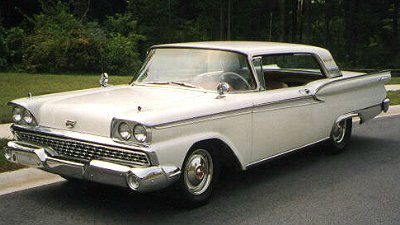 Comments:
Ford's fullsize Galaxie came with Ford's first factory-delivered muscle
car powerplant, the 352 Interceptor Special V8. Priced at just 5, the
optional Interceptor Special featured a hot solid-lifter cam, 10.6:1 compression,
a dual- point distributor, and an aluminum four-barrel carb. Advertised
horsepower was listed at 360 bhp. Comments:
Ford's fullsize Galaxie came with Ford's first factory-delivered muscle
car powerplant, the 352 Interceptor Special V8. Priced at just 5, the
optional Interceptor Special featured a hot solid-lifter cam, 10.6:1 compression,
a dual- point distributor, and an aluminum four-barrel carb. Advertised
horsepower was listed at 360 bhp.
Engines: 223 I6 135
bhp. 223 I6 145 bhp. 292 V8 175 bhp. 292 V8 185 bhp. 352 V8 300 bhp. 352
V8 360 bhp.
1960 Ford Galaxie
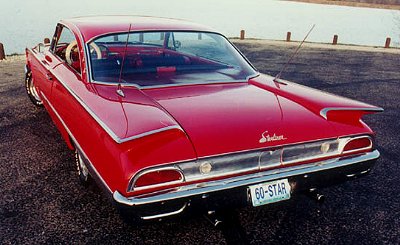 Comments:
1960 saw the dawn of a new era where performance was not the dirty word
as it has been. Ford's fullsize Ford, however, still only had a 352 V8
with 300 bhp as its top engine option, the same since 1958. The fullsize
Fords were bigger than ever for 1960. Wheelbase was up an inch to 119 inches,
overall length grew by 5.7 inches to 213.7 inches and overall width increased
by 3.9 inches to the widest ever at 81.5 inches, a full 1.5 inches wider
than federal highway standards allowed. Styling departed from the popular
but conservative 1959 models and included grille-mounted headlights and
gull wing fins. Topping the line was the sleek Starliner two-door hardtop
and its convertible counterpart, the Sunliner. Both were technically in
the Galaxie Special series and came with six cylinder or a number of eight
cylinder engines. But Ford jumped on the performance band wagon with the
introduction of its 352 cid Thunderbird Super V-8 that put out a respectable
360 bhp. Available on any fullsize 1960 model, it was also known as the
Interceptor and Super Interceptor and carried the R code. It was not initially
available with the Cruise-O-Matic, but rather the Borg-Warner T-85 three-speed,
with or without overdrive. A Holley 540-cfm four-barrel carburetor, aluminum
intake manifold, new cast iron exhaust headers, cast nodular crank, solid
lifters, 10.6:1 compression ratio and dual point ignition certainly helped. Comments:
1960 saw the dawn of a new era where performance was not the dirty word
as it has been. Ford's fullsize Ford, however, still only had a 352 V8
with 300 bhp as its top engine option, the same since 1958. The fullsize
Fords were bigger than ever for 1960. Wheelbase was up an inch to 119 inches,
overall length grew by 5.7 inches to 213.7 inches and overall width increased
by 3.9 inches to the widest ever at 81.5 inches, a full 1.5 inches wider
than federal highway standards allowed. Styling departed from the popular
but conservative 1959 models and included grille-mounted headlights and
gull wing fins. Topping the line was the sleek Starliner two-door hardtop
and its convertible counterpart, the Sunliner. Both were technically in
the Galaxie Special series and came with six cylinder or a number of eight
cylinder engines. But Ford jumped on the performance band wagon with the
introduction of its 352 cid Thunderbird Super V-8 that put out a respectable
360 bhp. Available on any fullsize 1960 model, it was also known as the
Interceptor and Super Interceptor and carried the R code. It was not initially
available with the Cruise-O-Matic, but rather the Borg-Warner T-85 three-speed,
with or without overdrive. A Holley 540-cfm four-barrel carburetor, aluminum
intake manifold, new cast iron exhaust headers, cast nodular crank, solid
lifters, 10.6:1 compression ratio and dual point ignition certainly helped.
Engines: 223 I6 135
bhp. 223 I6 145 bhp. 292 V8 175 bhp. 292 V8 185 bhp. 352 V8 300 bhp. 352
V8 360 bhp.
1961 Ford Galaxie
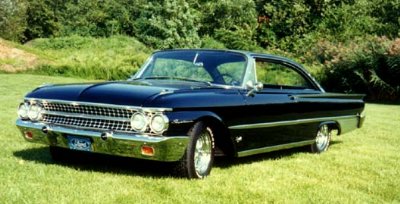 Comments:
Ford got serious with performance for 1961, and released a new 390 cid
V8 at the start of the year and a four-speed transmission at the end. In
1960, Ford announced that it had withdrawn support for the Automobile Manufacturers
Association's (AMA) four year ban on stock car racing and promotly showed
up at the Daytona Motor Speedway with a 360 bhp engined Galaxie Starliner
that ran 40 laps at an average of 142 mph. The new for '61 Starliner was
smaller sized, but bigger engined. Three versions of the 390 cid engine
were available. The base engine came with 300 bhp, while a police version
came with 330 bhp. At the top was the 375 bhp Thunderbird Super edition
with a four-barrel carb. At mid-year, Ford released a triple two-barrel
carb version of the 390 which put out up to 401 bhp. But despite the fact
that Ford had the most powerful engine available, it was lost in the excitement
of Chevrolet's 409. The Ford 390 V8 put out 375 bhp, and eventually 401
bhp, which was more than the 360 bhp that the Chevy 409 could put out.
But the Chevy's extra 19 cubic inches made it a hit on the street. Comments:
Ford got serious with performance for 1961, and released a new 390 cid
V8 at the start of the year and a four-speed transmission at the end. In
1960, Ford announced that it had withdrawn support for the Automobile Manufacturers
Association's (AMA) four year ban on stock car racing and promotly showed
up at the Daytona Motor Speedway with a 360 bhp engined Galaxie Starliner
that ran 40 laps at an average of 142 mph. The new for '61 Starliner was
smaller sized, but bigger engined. Three versions of the 390 cid engine
were available. The base engine came with 300 bhp, while a police version
came with 330 bhp. At the top was the 375 bhp Thunderbird Super edition
with a four-barrel carb. At mid-year, Ford released a triple two-barrel
carb version of the 390 which put out up to 401 bhp. But despite the fact
that Ford had the most powerful engine available, it was lost in the excitement
of Chevrolet's 409. The Ford 390 V8 put out 375 bhp, and eventually 401
bhp, which was more than the 360 bhp that the Chevy 409 could put out.
But the Chevy's extra 19 cubic inches made it a hit on the street.
Production: 390/401:
0-60 in 7 seconds, 1/4 mile in 15.1 seconds.
Engines: 223 I6 135
bhp. 223 I6 145 bhp. 292 V8 175 bhp. 292 V8 185 bhp. 352 V8 300 bhp. 352
V8 360 bhp. 390 V8 375 bhp @ 6000 rpm. 390 V8 401 bhp @ 6000 rpm.
1962 Ford Galaxie
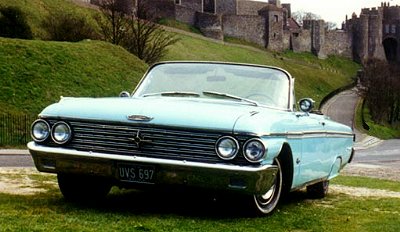 Comments:
Bowing to the supremacy of cubic inches on the street, Ford abandoned its
390 engine and introduced a brand new 406 cid V8, which it called the Thunderbird
406, even though it was never available in the Ford Thunderbird. The 406
came either with a single four barrel Holley carb rated at 385 bhp or three
Holley dual-barrel carbs rated at 405 bhp. With just under 1 bhp per cubic
inch, Ford found itself unable to match Chevy's improved 409 cid V8, which
produced 409 bhp. The Ford 406 engine went into the big and heavy full-size
Galaxies, and later in the Galaxie 500 and 500 XL which were introduced
in mid 1962. The 406 came as a package that included four on the floor
manual transmission, a number of optional low-ratio axles, 15 inch diameter
wheels instead of the standard 14 inchers fitted to regular Galaxies, fade-resistant
drum brakes, high capacity radiator, and a collection of heavy-duty suspension
pieces. Both versions of the 406 had 11.4:1 compression and cast-in headers
that led to low-restriction dual exhausts. Ford's Borg-Warner four-speed
manual was mandatory and axle ratios as high as 4.11:1 could replace the
standard 3.50:1 cog. Comments:
Bowing to the supremacy of cubic inches on the street, Ford abandoned its
390 engine and introduced a brand new 406 cid V8, which it called the Thunderbird
406, even though it was never available in the Ford Thunderbird. The 406
came either with a single four barrel Holley carb rated at 385 bhp or three
Holley dual-barrel carbs rated at 405 bhp. With just under 1 bhp per cubic
inch, Ford found itself unable to match Chevy's improved 409 cid V8, which
produced 409 bhp. The Ford 406 engine went into the big and heavy full-size
Galaxies, and later in the Galaxie 500 and 500 XL which were introduced
in mid 1962. The 406 came as a package that included four on the floor
manual transmission, a number of optional low-ratio axles, 15 inch diameter
wheels instead of the standard 14 inchers fitted to regular Galaxies, fade-resistant
drum brakes, high capacity radiator, and a collection of heavy-duty suspension
pieces. Both versions of the 406 had 11.4:1 compression and cast-in headers
that led to low-restriction dual exhausts. Ford's Borg-Warner four-speed
manual was mandatory and axle ratios as high as 4.11:1 could replace the
standard 3.50:1 cog.
Although a Galaxie did well
in initial acceleration, its heavy weight and poor aerodynamics counted
against it and the best it could do was quarter miles in the high 15s.
The new restyled roofline of the 1962 Galaxie's created more drag than
the 1961's. To improve the Galaxie's showing in NASCAR, Ford attempted
to improve the Galaxie's aerodynamics by offering several options on the
production versions. First they announced a "Starlift" detachable hardtop
for the Galaxie Sunliner convertible which would improve overall aerodynamics.
NASCAR refused to accept Ford's arguement that this was a regular production
option and refused to allow the Galaxie's to race with them. Ford then
announced the availablity of weight saving aluminum bumpers and fiberglass
body panels for the Galaxies, but again NASCAR refused to accept them as
production options. As a result, the light weight Galaxies were forced
to run in the Factory Experimental Class, were they did not gather the
publicity that Ford wanted. Although the 406 powered Galaxies did not capture
the publicity that Ford wanted, it was a good attempt none the less. The
top of the line Galaxie 500 XL had bucket seats and a center console, which
were becoming more important in the high performance market. Complimenting
this increased performance was some of the cleanest styling available in
1962.
Engines: 292 V8 170
bhp. 352 V8 220 bhp. 390 V8 300/330 bhp. 406 V8 385 bhp @ 5800 rpm, 440
lb-ft @ 3800 rpm. 406 V8 405 bhp, 448 lb-ft.
Performance: 406/405:
0-60 in 6.5 sec, 1/4 mile in 15.4 sec @ 93mph
1963 Ford Galaxie
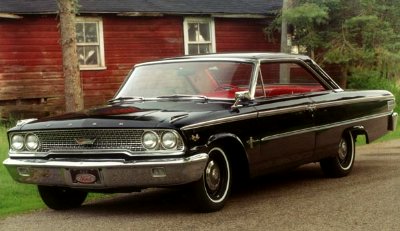 Comments:
Ford rebounded from its poor showing in 1962 to win 23 Grand National NASCAR
races, including the top five places at Daytona. This sucess was due to
two factors, both introduced mid way through the 1963 model year (1963
1/2 according to Ford). The first was a new sleek Sports Roof body for
the two door Galaxie, which was two inches lower than the regular hardtop
and offered better aerodynamics. The second were two new engines that replaced
the 406, known as the Ford 427. The Ford 427 was a big bore development
of the 406 and actually displaced 425 cubic inches, but Ford called it
a 427 anyway to play on NASCAR's maximum engine size restriction. The new
engine had a light weight valvetrain with solid lifters which improved
high revs, while bottom-end strength was taken care of by cross-bolted
main bearing caps. With a single 780-cfm four-barrel Holley caruretor,
the Ford 427 was rated at 410 bhp at 5,600 rpm and cost an extra 6.
Outfitted with two 652-cfm four-barrel Holley carbs, it put at 425 bhp
at 6,000 rpm and cost an extra 2. A four speed manual was a mandatory
8 option. Both 427s came with 11.5:1 compression, an aluminum manifold,
and performance packages which included heavy-duty suspensions, axles,
and brakes, together with uprated driveshafts and universal joints. All
high performance Galaxies came with 15 inch wheels, as oppesed to the standard
14 inchers. But the Galaxies were still heavy, weighing between 3,500 and
4,000 lbs. and although they did well on high speed tracks, they lagged
behind on the drag strips and on the streets. To counter this, Ford built
50 special light weight Sports Roof Galaxies for competition. They had
stripped interiors, ultra-lightweight bucket seats, together with aluminum
transmission casings and bell-housings. Fiberglass was used for the bumpers,
front fenders, and the "bubble" hood which was necessary to clear a special
aluminum high-rise manifold. Some cars even had fiberglass doors. With
the 425 bhp 427 engine, these lightweights were able to turn the quarter
mile in 12.07 seconds at 118 mph. However, they were outgunned on the streets
by hot Chevys, Dodges, and Plymouths, where it counted. Comments:
Ford rebounded from its poor showing in 1962 to win 23 Grand National NASCAR
races, including the top five places at Daytona. This sucess was due to
two factors, both introduced mid way through the 1963 model year (1963
1/2 according to Ford). The first was a new sleek Sports Roof body for
the two door Galaxie, which was two inches lower than the regular hardtop
and offered better aerodynamics. The second were two new engines that replaced
the 406, known as the Ford 427. The Ford 427 was a big bore development
of the 406 and actually displaced 425 cubic inches, but Ford called it
a 427 anyway to play on NASCAR's maximum engine size restriction. The new
engine had a light weight valvetrain with solid lifters which improved
high revs, while bottom-end strength was taken care of by cross-bolted
main bearing caps. With a single 780-cfm four-barrel Holley caruretor,
the Ford 427 was rated at 410 bhp at 5,600 rpm and cost an extra 6.
Outfitted with two 652-cfm four-barrel Holley carbs, it put at 425 bhp
at 6,000 rpm and cost an extra 2. A four speed manual was a mandatory
8 option. Both 427s came with 11.5:1 compression, an aluminum manifold,
and performance packages which included heavy-duty suspensions, axles,
and brakes, together with uprated driveshafts and universal joints. All
high performance Galaxies came with 15 inch wheels, as oppesed to the standard
14 inchers. But the Galaxies were still heavy, weighing between 3,500 and
4,000 lbs. and although they did well on high speed tracks, they lagged
behind on the drag strips and on the streets. To counter this, Ford built
50 special light weight Sports Roof Galaxies for competition. They had
stripped interiors, ultra-lightweight bucket seats, together with aluminum
transmission casings and bell-housings. Fiberglass was used for the bumpers,
front fenders, and the "bubble" hood which was necessary to clear a special
aluminum high-rise manifold. Some cars even had fiberglass doors. With
the 425 bhp 427 engine, these lightweights were able to turn the quarter
mile in 12.07 seconds at 118 mph. However, they were outgunned on the streets
by hot Chevys, Dodges, and Plymouths, where it counted.
Engines: 289 V8 195
bhp. 352 V8 220 bhp. 390 V8 300 bhp. 390 V8 330 bhp. 427 V8 410 bhp @ 5600
rpm. 427 V8 425 bhp @ 6000 rpm, 480 lb-ft.
Performance: 427/425:
0-60 in 7.4 sec, 1/4 mile in 15.4 sec @ 95mph
1964 Ford Galaxie
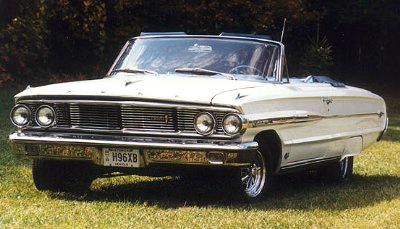 Comments:
The fullsize Galaxies were restyled for 1964, and the sleek fastback roof
was carried over along with the 427 engine. Newly available was an optional
High-Riser manifold. Also new was a "high rev" package. They still dominated
the high speed NASCAR races, but their heavy weight hurt them on the drag
strips and the street. Comments:
The fullsize Galaxies were restyled for 1964, and the sleek fastback roof
was carried over along with the 427 engine. Newly available was an optional
High-Riser manifold. Also new was a "high rev" package. They still dominated
the high speed NASCAR races, but their heavy weight hurt them on the drag
strips and the street.
Engines: 289 V8 195
bhp. 352 V8 220 bhp. 390 V8 300 bhp. 390 V8 330 bhp. 427 V8 410 bhp. 427
V8 425 bhp.
1965 Ford Galaxie
Comments: The Galaxies
were remodeled for 1965, with sharper styling creases and stacked headlights,
and sported a redesigned and tougher front suspension. A new heavy duty
"nine inch" differential could be ordered as an option. But the real news
came in mid season with the introduction of two new engines. The less powerful
was the Thunderbird 427 Super High Perforance V8, which was a development
of the existing 427. Maximum power was unchanged, but competition durability
had been improved by means of a large oil gallery low down on the left-hand
side of the block, which gave lubrication. With a single four barrel carb,
it produced 410 bhp. With dual four barrels, it produced 425 bhp. The so-called
"side oiler" engine in the Galaxies was nevertheless overshadowed by the
"cammer."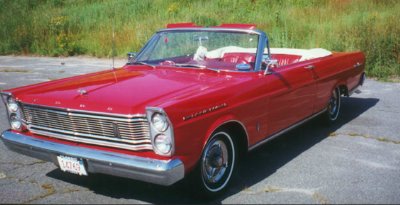
The "cammer" 427 was in
1965, and probably remains till today, the most powerful production engine
ever made. Developed with the intention of taking on Chrysler's Hemis,
Ford gave the 427 block new heads with hemispherical combustion chambers.
To cap that, they fitted overhead camshafts -- one per cylinder bank --
which gave the engine its name. With the regular single four barrel carb,
the "cammer" put out 616 bhp, but with dual four-barrels, it produced a
massive 657 bhp. With this kind of power, the "cammer" 427 was totally
unsuitable for street use. This kept sales and therefore production volumes
down and NASCAR refused to accept the engine as a regular production option.
Nonetheless, Ford gained a lot of publicity in other events which greatly
helped their image on the street.
Engines: 289 V8 195
bhp. 289 V8 200 bhp. 352 V8 250 bhp. 390 V8 275 bhp. 390 V8 300 bhp. 390
V8 315 bhp. 427 V8 410 bhp. 427 V8 425 bhp. 427 Cammer V8 (1x4bbl) 616bhp
@ 7500rpm. 427 Cammer V8 (2x4bbl) 657 bhp @ 7500rpm, 550 lb-ft.
Performance: 427/425:
0-60 in 4.8 seconds, 1/4 mile in 14.9 seconds.
1966 Ford Galaxie
Comments: Despite
the publicity earned by the Ford "Cammer 427", enthusiasts were quick to
realize that the engine was not available in the real world so it didn't
have much of an impact on the street. Only 237 Fords with the 427 engine
were sold in 1966. Realizing that the days of full size muscle cars was
over, Ford replaced its high performance 427 V8 with 425 bhp with a new
428 V8 with only 345 bhp that was tuned more for smoothness than power.
Promoted as the new "7-litre" model, the top line 428 powered Galaxie was
tuned more for smoothness than power which signaled the end of fullsize
Ford power.
Engines: 289 V8 195
bhp. 289 V8 200 bhp. 352 V8 250 bhp. 390 V8 275 bhp. 390 V8 300 bhp. 390
V8 315 bhp. 427 V8 410 bhp. 427 V8 425 bhp. 428 V8 345 bhp.
Performance: 428/345:
1/4 mile in 16.9 seconds.
1967 Ford Galaxie
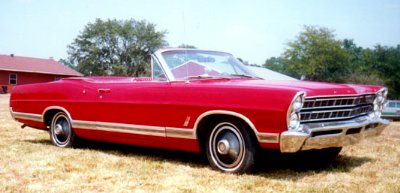 Comments:
Ford began to stress big car luxury in 1967 which meant more size and weight,
but less emphasis on muscle. Although technically the two 427 engines were
offered, most buyers opted for the less expensive 428 if they wanted cubic
inches. The "7 litre" was demoted from full model line status to optional
sport package in 1967. Priced at 5.86, the "7-Litre Sport Package" included
the 345 bhp 428 cid V8 with a C6 automatic, power front disc brakes, and
the bucket seat XL interior with a sport steering wheel. Few buyers noticed
as only 50 7-Litres were built in 1967. Comments:
Ford began to stress big car luxury in 1967 which meant more size and weight,
but less emphasis on muscle. Although technically the two 427 engines were
offered, most buyers opted for the less expensive 428 if they wanted cubic
inches. The "7 litre" was demoted from full model line status to optional
sport package in 1967. Priced at 5.86, the "7-Litre Sport Package" included
the 345 bhp 428 cid V8 with a C6 automatic, power front disc brakes, and
the bucket seat XL interior with a sport steering wheel. Few buyers noticed
as only 50 7-Litres were built in 1967.
Engines: 289 V8 200
bhp. 390 V8 270 bhp. 390 V8 320 bhp. 390 V8 335 bhp. 427 V8 410 bhp. 427
V8 425 bhp. 428 V8 345 bhp.
1968 Ford Galaxie
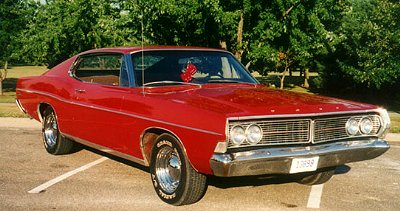 Comments:
Ford fullsize performance suffered again with the drop of the 425 bhp 427
cubic inch engine - not that anyone noticed. New this year was the top
of the line Galaxie XL GT. The GT package was priced at 4.64, and included
a heavy-duty suspension, power front discs, low-restriction dual exhausts,
wide-oval rubber, mag-type wheel covers, GT badges, and special body side
"C-stripes." A 390 cid V8 was the standard power source, but a 428 cid
V8 was optional. The GT package separated performance Galaxies from the
XL series which no longer came with standard bucket seats and V-8 power. Comments:
Ford fullsize performance suffered again with the drop of the 425 bhp 427
cubic inch engine - not that anyone noticed. New this year was the top
of the line Galaxie XL GT. The GT package was priced at 4.64, and included
a heavy-duty suspension, power front discs, low-restriction dual exhausts,
wide-oval rubber, mag-type wheel covers, GT badges, and special body side
"C-stripes." A 390 cid V8 was the standard power source, but a 428 cid
V8 was optional. The GT package separated performance Galaxies from the
XL series which no longer came with standard bucket seats and V-8 power.
1969 Ford Galaxie
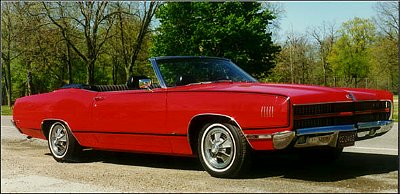 Comments:
For 1969, the Ford Galaxie sported a new sleek SportsRoof fastback body
style with a recessed rear window and hideaway headlights. In base form,
a '69 XL GT was powered by a 265 bhp 390 cid V8 with a two barrel carb.
Available at extra cost were two 429 cid V8s, one with a two-barrel carb
rated at 320 bhp and another with a four-barrel carb rated at 360 bhp and
480 lb-ft. The Ford Galaxie needed that power just to move its 4,135 pounds
of weight. Comments:
For 1969, the Ford Galaxie sported a new sleek SportsRoof fastback body
style with a recessed rear window and hideaway headlights. In base form,
a '69 XL GT was powered by a 265 bhp 390 cid V8 with a two barrel carb.
Available at extra cost were two 429 cid V8s, one with a two-barrel carb
rated at 320 bhp and another with a four-barrel carb rated at 360 bhp and
480 lb-ft. The Ford Galaxie needed that power just to move its 4,135 pounds
of weight.
Engines: 390 V8 265
bhp. 429 V8 320 bhp. 429 V8 360 bhp, 480 lb-ft.
|